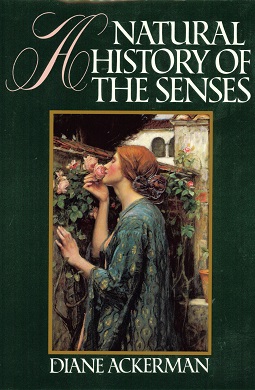A Natural History of the Senses
A Natural History of the Senses is a book written by American author Diane Ackerman. Published in 1990, it delves into the complexities and delights of the five senses—taste, touch, smell, sight, and hearing—exploring how they define the human experience and connect individuals to the world around them. Ackerman's work is celebrated for its poetic language and rich descriptive narratives that draw from various disciplines, including biology, literature, history, and psychology, to illuminate the wonders and workings of human perception.
Overview[edit | edit source]
A Natural History of the Senses is divided into sections, each dedicated to one of the senses. Ackerman employs a multidisciplinary approach, blending scientific facts with personal anecdotes, historical vignettes, and cultural insights to explore the roles and perceptions of the senses throughout human history. Her exploration goes beyond the biological mechanisms to ponder the emotional and psychological resonances that the senses evoke in our daily lives.
Taste[edit | edit source]
The section on taste examines not only the biological basis of this sense but also its cultural and emotional significance. Ackerman discusses the evolution of human taste preferences, the role of taste in survival, and its connection to memory and emotion.
Touch[edit | edit source]
In discussing touch, Ackerman explores the skin as the largest and perhaps most emotionally resonant organ. She delves into the importance of touch in human development, communication, and bonding, highlighting its fundamental role in conveying love and trust.
Smell[edit | edit source]
The chapter on smell reveals its powerful link to memory and emotion, more so than any other sense. Ackerman discusses the olfactory system and how smells can instantly transport us to different times and places, evoking vivid memories and emotions.
Sight[edit | edit source]
The sight section contemplates the dominance of vision in human perception and culture. Ackerman explores the science of seeing, the beauty we derive from visual experiences, and the ways in which sight influences art, literature, and our understanding of the world.
Hearing[edit | edit source]
Finally, the hearing segment reflects on the importance of sound in human life, from the development of language to the enjoyment of music. Ackerman examines how sounds can soothe, alarm, or delight us, and how they shape our interaction with the environment.
Reception[edit | edit source]
A Natural History of the Senses has been widely praised for its insightful and lyrical examination of the senses. Readers and critics alike have lauded Ackerman's ability to weave together science and art, making complex concepts accessible and engaging. The book has been used in various educational settings, from biology to literature courses, highlighting its interdisciplinary appeal.
Legacy[edit | edit source]
Ackerman's work has contributed significantly to popular science writing, inspiring further exploration into the sensory experiences that define the human condition. A Natural History of the Senses has encouraged readers to pay closer attention to the world around them, deepening their appreciation for the sensory inputs that enrich life.
Search WikiMD
Ad.Tired of being Overweight? Try W8MD's physician weight loss program.
Semaglutide (Ozempic / Wegovy and Tirzepatide (Mounjaro / Zepbound) available.
Advertise on WikiMD
|
WikiMD's Wellness Encyclopedia |
| Let Food Be Thy Medicine Medicine Thy Food - Hippocrates |
Translate this page: - East Asian
中文,
日本,
한국어,
South Asian
हिन्दी,
தமிழ்,
తెలుగు,
Urdu,
ಕನ್ನಡ,
Southeast Asian
Indonesian,
Vietnamese,
Thai,
မြန်မာဘာသာ,
বাংলা
European
español,
Deutsch,
français,
Greek,
português do Brasil,
polski,
română,
русский,
Nederlands,
norsk,
svenska,
suomi,
Italian
Middle Eastern & African
عربى,
Turkish,
Persian,
Hebrew,
Afrikaans,
isiZulu,
Kiswahili,
Other
Bulgarian,
Hungarian,
Czech,
Swedish,
മലയാളം,
मराठी,
ਪੰਜਾਬੀ,
ગુજરાતી,
Portuguese,
Ukrainian
Medical Disclaimer: WikiMD is not a substitute for professional medical advice. The information on WikiMD is provided as an information resource only, may be incorrect, outdated or misleading, and is not to be used or relied on for any diagnostic or treatment purposes. Please consult your health care provider before making any healthcare decisions or for guidance about a specific medical condition. WikiMD expressly disclaims responsibility, and shall have no liability, for any damages, loss, injury, or liability whatsoever suffered as a result of your reliance on the information contained in this site. By visiting this site you agree to the foregoing terms and conditions, which may from time to time be changed or supplemented by WikiMD. If you do not agree to the foregoing terms and conditions, you should not enter or use this site. See full disclaimer.
Credits:Most images are courtesy of Wikimedia commons, and templates Wikipedia, licensed under CC BY SA or similar.
Contributors: Prab R. Tumpati, MD

